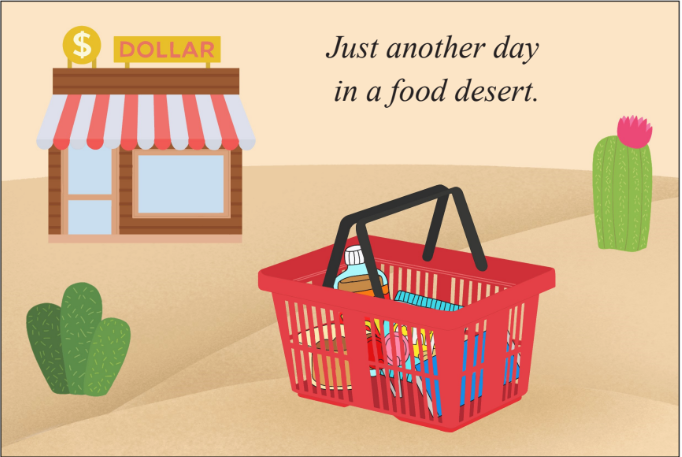
Nov. 13, 2023
When people are hungry and require food, they head to their local supermarket in search of products to meet their needs. However, those who live in food deserts have a difficult time getting to their nearest grocery store.
The U.S. Department of Agriculture defines a food desert as a tract with at least 500 people or 33% of the population living more than one mile in urban areas or 10 miles in rural areas from the nearest grocery store, supercenter or supermarket.
Food deserts tend to be in financially struggling areas where people do not have cars and rely on public transportation. In the United States, over 2.1 million households do not own a vehicle or live within 20 miles of a supermarket, according to the non-profit, non-partisan health policy advocacy organization Trust for America’s Health.
According to National Public Radio, the cost of traveling by bus could be prohibitive for people who need to shop multiple times a week. This is why financially struggling people along with the elderly are especially impacted by food deserts.
The problems associated with food deserts were heightened during the pandemic due to strict travel rules. According to Michigan State University’s Institute for Food Laws and Regulations, lack of transportation and unemployment were the main factors affecting residents in food deserts.
Without a nearby supermarket, those living in food deserts turn to bodegas, convenience stores and fast-food establishments, which results in diets dominated by processed foods high in fat, sodium and sugar, according to Medical News Today, a medical news website.
The ratio of grocery stores to bodegas is particularly problematic. The New York City Food Policy Center reported in 2022 that there was one supermarket for every 37 bodegas in the Belmont and East Tremont sections of the Bronx in New York City.
While dollar stores can, to an extent, fill the void by providing some healthy food options, their products are often placed in areas far from customers’ eyes, which can make them hard to find.
While dollar stores can, to an extent, fill the void by providing some healthy food options, their products are often placed in areas far from customers’ eyes, which can make them hard to find. Dollar stores also put financial strain on existing supermarkets because they can take away just enough of a supermarket’s profits that it cannot stay open. Similarly, a supermarket chain may choose not to move into an area with dollar stores due to anticipated financial challenges, according to PIX11.
The National Library of Medicine reports that it can be hard for cities and overpopulated towns to find space to build new supermarkets. Big supermarket chains also think twice about moving into low-income areas where they believe local residents will have a hard time affording food from a grocery store, according to PIX11.
The New Jersey Economic Development Authority Board is to be commended for its April 12 ruling in favor of the Food Desert Relief Tax Credit Program, which will provide $40 million per year in grants, loans, tax credits and technical assistance to increase access to nutritious foods and develop new approaches to alleviate food deserts.

ILLUSTRATION BY ALEX SKOWRONSKI
According to the NJEDA’s website, this program sets out to strengthen supermarkets in food deserts and attract more supermarkets to those areas.
There is also the Healthy Food Financing Initiative, which is spearheaded by the U.S. Department of Agriculture and the Reinvestment Fund. It provides grants, loans and resources to urban and rural communities to improve access to healthy foods.
Every American should have access to healthy food options that can be purchased at a nearby grocery store. Eliminating food deserts will require effort and cooperation between communities, local and state governments and private companies, but it is worthwhile to alleviate this serious problem.


